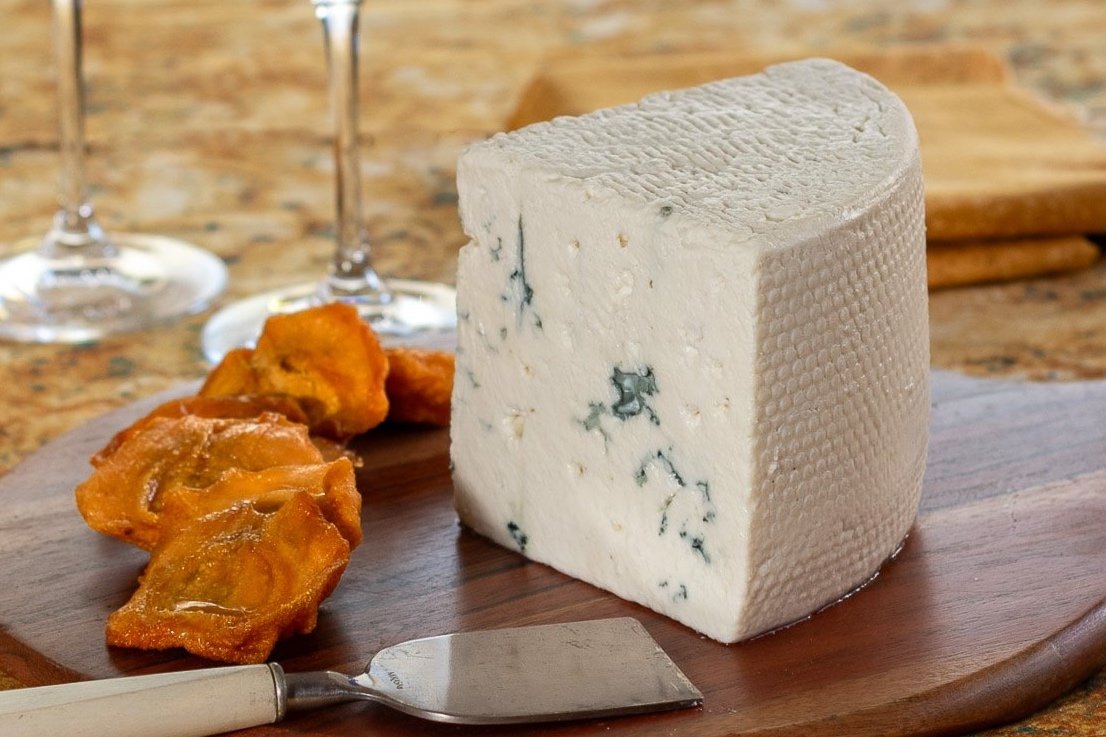Most cheese counters I visit—even the best ones—have a big gap in goat blues. The options just aren’t there, domestic or imported. It’s not an easy style to make, according to the cheesemaker who just launched the one pictured here. Goat curd is dense and wants to mat. If it doesn’t remain open and airy, it’s hard for blue veins to grow. But the flavor of a well-made goat blue can be captivating—more tangy than buttery, sometimes closer to feta than to Stilton. I’ve fallen for several over the years—Persillé de Rambouillet from France, Andazul from Spain, Harbourne Blue from the U.K.—but then they vanish. Let’s hope this California newcomer finds an audience and sticks around.
The producer is Shooting Star Creamery, a sheep cheese specialist in Paso Robles. Cheese geeks will recognize that creamery as the home base of whiz-kid cheesemaker Avery Jones who won her first American Cheese Society blue ribbon at 15 for Aries. Avery is now about to finish college and headed for a PhD program in environmental biology, so her cheesemaking days may be numbered. Fortunately, her dad can step in.
Mentor dad: Reggie Jones
Reggie Jones, Avery’s father and mentor, runs Central Coast Creamery. About a year ago he and Avery began discussing the serious shortage of fresh sheep’s milk in California and how her business might adapt. “We needed to have more stability in the brand,” says Reggie. Enter Capricorn (pictured above), Shooting Star’s first goat cheese.
Why a goat blue? “Because there are so few,” says Reggie. “And goat milk products are on a huge trajectory.”
The challenge with Capricorn is to keep the wheel open-textured enough that the blue mold can find air pockets. Goat curd is heavy and “crushes on itself,” says Reggie. “You get less veining, but I do love the flavor.” As did I. And my husband, not typically a blue fan, fell hard for this one.
Shoorting for the stars: Cheesemaker Avery Jones
A five-pound wheel of Capricorn is firm, rindless and chalk white at three months—its release date—with a modest amount of veining. It smells tangy, lactic and briny, a bit like goat feta. The texture is on the dry side compared to most blues; I would love it a little creamier. I’m curious how others will perceive the salt level. To me it’s a tad over the top but several professional colleagues I asked didn’t agree. I’ll be serving Capricorn in an upcoming cheese class and we’ll see what others think. It is certainly handsome, with a mellow nature that should have broad appeal.
Blue cheeses are saltier than other types for a reason. To encourage the Penicillium to proliferate, blue wheels are aged in a relatively warm cellar; the extra salt provides extra safety and discourages undesirable microorganisms. Salt also promotes draining—especially important because blues aren’t pressed. An undersalted blue can retain too much whey, which leads to texture, flavor and ripening issues, says Zoe Brickley of Jasper Hill Farm.
A typical Cheddar might be 1.7 percent salt by weight. Brickley says Jasper Hill aims for around 2 percent salt for its Bayley Hazen and Withersbrook blues.
“If you go much over 2.5 percent, it will really taste salty,” said Sid Cook, a certified Wisconsin Master Cheesemaker and owner of Carr Valley Creamery. Carr Valley’s Billy Blue is another goat’s milk treasure but near impossible to find where I live. Lively Run Dairy’s award-winning Cayuga Blue, a goat wheel from New York, also tends to stay close to home.
Beyond the Western U.S., Capricorn will likewise be a rarity. “It’s not meant to be mass produced,” says Reggie. “A hundred wheels a month is gonna be it.”
Look for Shooting Star Creamery’s Capricorn at these retail stores.



